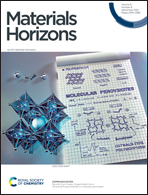Polyphenol-mediated chitin self-assembly for constructing a fully naturally resourced hydrogel with high strength and toughness†
Abstract
Natural polymeric hydrogels are expected to serve as potential structural biomaterials, but, most of them are usually soft and fragile. Herein, a polyphenol-mediated self-assembly (PMS) strategy was developed to significantly enhance the chitin hydrogel strength and toughness at the same time, which is distinctive from the rigid–soft double-network energy-dissipation approaches. A polyphenol (tannic acid, TA as a model compound) was introduced to compete with the chitin chains self-assembly for simultaneously forming the weak chitin–TA and strong chitin–chitin networks. High-density noncovalent crosslinking involving hydrogen bonding and ionic and hydrophobic interactions endowed the PMS hydrogels with a high modulus and strength. The relatively weaker chitin–TA crosslinking acted as the sacrificial bonds to dissipate the energy, leading to the high toughness. The mechanical properties of the PMS chitin hydrogels depended on the TA concentration and ethanol aqueous coagulation, which mainly contributed to the hydrophobic and hydrophilic interactions formation, respectively. The fully naturally robust chitin–TA hydrogels exhibited considerable antibacterial properties, stomach acid solubility, and excellent biocompatibility and degradability, enabling their potential in food, biomedical, and sustainable applications.



 Please wait while we load your content...
Please wait while we load your content...